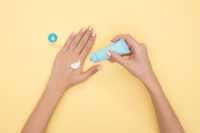
30 May Don’t Get Burned by Homemade Sunscreens
MedicalResearch.com Interview with:
Lara B. McKenzie, PhD, MA
Principal Investigator in the Center for Injury Research and Policy
Research Institute at Nationwide Children’s Hospital
Associate Professor in the Department of Pediatrics
College of Medicine and the Division of Epidemiology
College of Public Health at The Ohio State University
MedicalResearch.com: What is the background for this study? What are the main findings?
Response: Social media and other online tools have changed the way people seek and share health information. Recent consumer interest in natural, organic, and ethically-made personal care products has led to an increase of shared recipes for homemade products including sunscreen.
The study found that nearly all (95%) pins, or bookmarks, for homemade sunscreen positively portrayed the effectiveness of homemade sunscreens and most (68%) recommended recipes for homemade sunscreens that offered insufficient UV radiation protection. Sun Protection Factor (SPF) claims were made in a third of pins with a range of SPF 2 to SPF 50. This is concerning because the ingredients recommended in homemade sunscreen pins offer minimal scientifically proven broad-spectrum protection from UV radiation yet are widely shared and promoted as safe alternatives to commercial sunscreens on Pinterest.
Homemade sunscreen products are risky because they are not regulated or tested for efficacy like commercial sunscreens. When you make it yourself, you don’t know if it’s safe or effective. With rising skin cancer rates, the use of effective broadband sunscreen is critical to protect the skin from UV radiation and reduce incidence of skin cancer.
MedicalResearch.com: What should readers take away from your report?
Response: Just because you make it yourself or something is labeled as natural, organic, non-toxic, or has fewer ingredients doesn’t necessarily mean it’s safer (or less expensive). In fact, the recipes reviewed in our study had varying SPF claims ranging from 2 to 50 but unfortunately the claims cannot be confirmed or tested when you make your own sunscreen. Some of the ingredients do offer some inherent protections but not to the level of commercially available sunscreens. The best sunscreen is one that can be regularly applied and stay on the skin without causing irritation or other side effects. It often takes a trial of several sunscreens before finding the one that does the job best for your family, even if that means everyone uses a different type of product. Here are some tips on how to protect your child’s skin:
- Use an FDA-approved sunscreen. The American Academy of Dermatology recommends that everyone 6 months and older wear sunscreen. Make sure the sunscreen has these characteristics:
- Broad spectrum, which protects against UVA and UVB sunrays.
- Water-resistant (effective for up to 40 minutes in water) or very water resistant (effective for up to 80 minutes in water).
- Sun Protection Factor (SPF) of 30 or higher.
- Start early. Children whose parents regularly apply sunscreen at an early age are more likely to continue using sunscreen as teenagers and adults. Make a habit of using sunscreen to set kids up for a lifetime of safely enjoying outdoor activities. Model good sunscreen behavior.
- Apply early and often.Sunscreen should be applied in a thick layer (about ¼ teaspoon for a toddler’s face), 30 minutes before heading outside and reapplied every 2 hours. If children are swimming or sweating a lot, reapply sunscreen more often and use a water-resistant formula. For a week-long beach vacation, a school-aged child should go through an entire 8 oz. bottle of sunscreen, applying it twice a day.
- Throw out expired or old sunscreen. Look for an expiration date on the bottle and throw out expired sunscreen. If there is no expiration date, throw out sunscreen three years after opening. If your sunscreen looks or feels really different – it’s much thicker or thinner or the color has changed – throw it out.
MedicalResearch.com: What recommendations do you have for future research as a result of this work?
Response: This study offered insight into the influence of social media on health behavior and reinforces the need for public health organizations to engage with the general population through social media to educate and counteract detrimental health information. Additionally, we need to further investigate the actual behaviors of Pinterest users to find out if they are engaging in the behaviors that they share on social media.
I have no financial relationships or potential conflicts of interest relevant to this article to disclose.
Citation:
Pinterest Homemade Sunscreens: A Recipe for Sunburn.
Merten JW, Roberts KJ, King JL, McKenzie LB.
Health Commun. 2019 May 21:1-6. doi: 10.1080/10410236.2019.1616442. [Epub ahead of print]
PMID: 31111735
[wysija_form id=”3″]
[last-modified]
The information on MedicalResearch.com is provided for educational purposes only, and is in no way intended to diagnose, cure, or treat any medical or other condition. Always seek the advice of your physician or other qualified health and ask your doctor any questions you may have regarding a medical condition. In addition to all other limitations and disclaimers in this agreement, service provider and its third party providers disclaim any liability or loss in connection with the content provided on this website.
Last Updated on May 30, 2019 by Marie Benz MD FAAD

